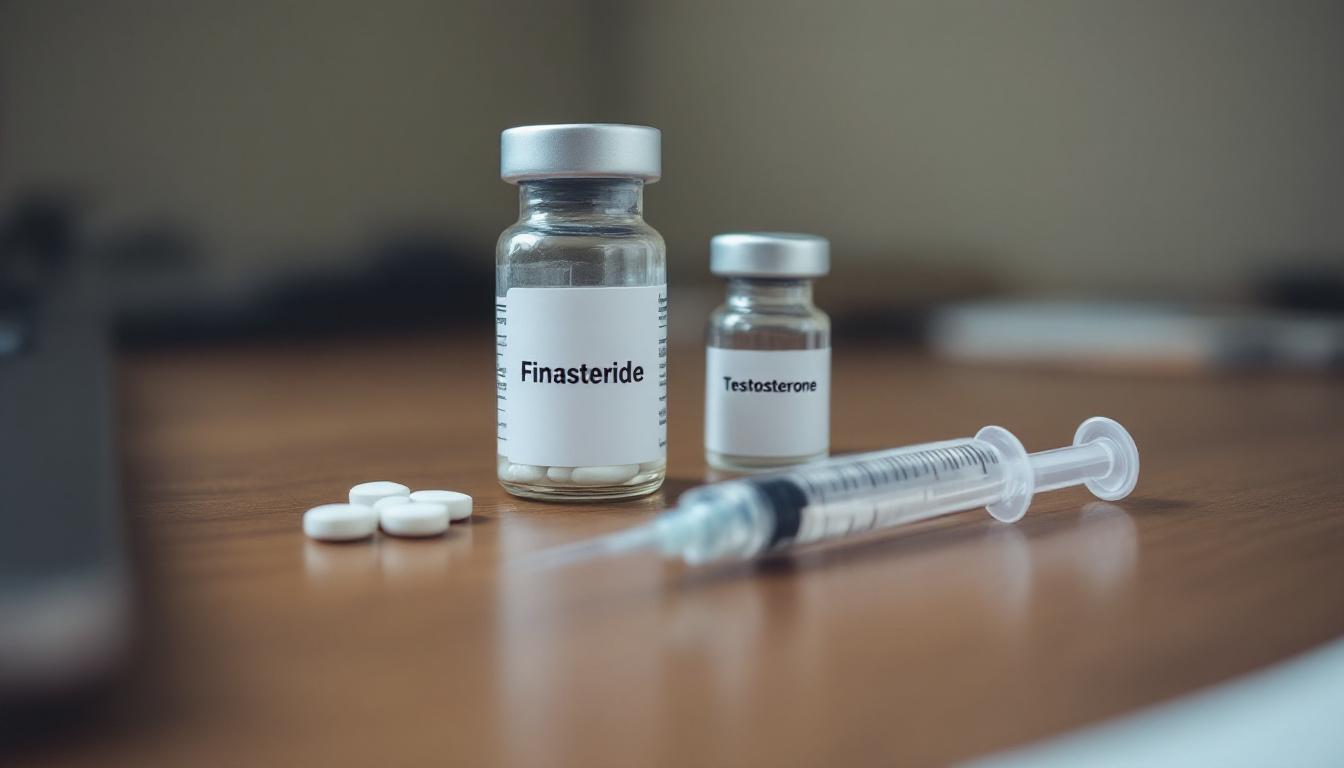At SaltMD, we’re often asked about the relationship between Finasteride and testosterone replacement therapy (TRT). These two treatments, while serving different primary purposes, can significantly impact men’s health when used together.
In this comprehensive guide, we’ll explore how Finasteride and TRT work, their potential synergies, and the important considerations for those contemplating or currently using both treatments.
What Are Finasteride and TRT?
Finasteride: The DHT Blocker
Finasteride is a medication doctors prescribe to treat male pattern baldness and benign prostatic hyperplasia (BPH). It inhibits the enzyme 5-alpha reductase, which converts testosterone into dihydrotestosterone (DHT). DHT shrinks hair follicles and contributes to male pattern baldness.
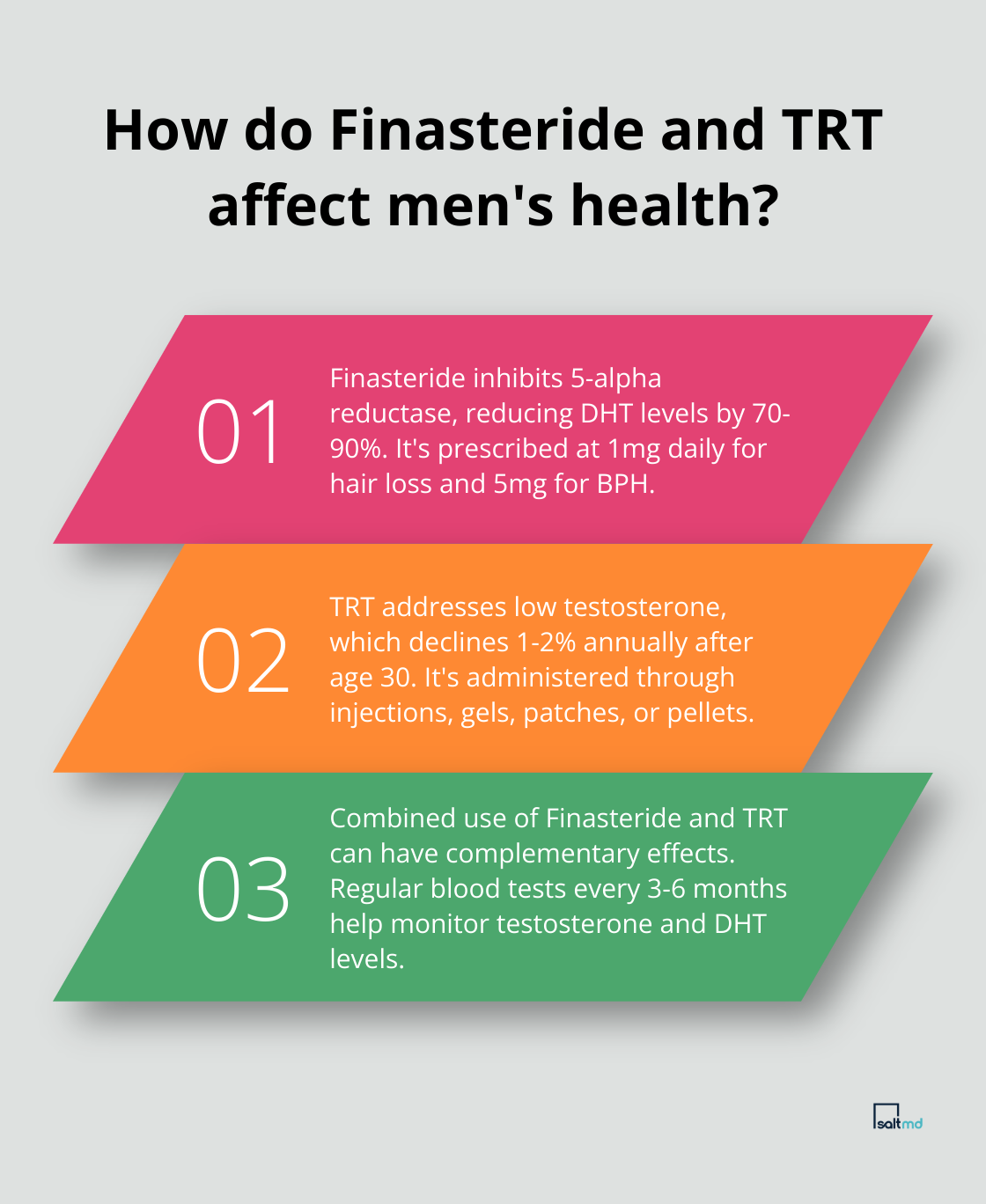
Doctors typically prescribe 1mg daily for hair loss treatment and 5mg for BPH. Research indicates that finasteride can reduce DHT levels by 70-90%, which explains its effectiveness in slowing or stopping hair loss for many men.
TRT: Boosting Testosterone Levels
Testosterone Replacement Therapy (TRT) addresses low testosterone levels in men. Men’s testosterone production naturally declines as they age – typically by 1-2% per year after age 30 (Brawer, 2004).
TRT aims to restore testosterone levels to a normal range. This can alleviate symptoms like decreased libido, fatigue, muscle loss, and mood changes. Doctors administer TRT through various methods, including injections, gels, patches, and pellets.
The Interplay Between Finasteride and TRT
Finasteride and TRT can have complementary effects when used together. TRT increases overall testosterone levels, which can lead to more DHT production. Finasteride, by blocking the conversion of testosterone to DHT, can help mitigate potential hair loss side effects of TRT.
Chen et al. (2020) highlighted that it’s not just the absolute level of DHT that matters, but also the sensitivity of hair follicles to DHT. This explains why some men on TRT may experience hair loss while others don’t.
Monitoring and Adjusting Treatment
Regular blood tests are essential when using finasteride and TRT together. These tests help track testosterone and DHT levels, allowing for precise adjustments to treatment plans. Doctors often recommend checking levels every 3-6 months, or more frequently when starting or changing treatments.
It’s important to note that while finasteride and TRT can be powerful tools for men’s health, they’re not one-size-fits-all solutions. Each man’s body responds differently, and what works for one may not work for another.
Personalized Approach to Treatment
A personalized treatment plan based on individual health profiles and goals is key to success with finasteride and TRT. This approach takes into account factors such as age, overall health, specific symptoms, and treatment goals.
For example, a man in his 40s experiencing both hair loss and low testosterone symptoms might benefit from a combination of low-dose finasteride and TRT. On the other hand, an older man primarily concerned with prostate health might focus more on finasteride.
The next chapter will explore the potential benefits and synergistic effects of combining finasteride and TRT, as well as important dosage considerations and administration methods.
Maximizing Benefits of Finasteride and TRT
Synergistic Effects on Health
The combination of finasteride and TRT addresses multiple health concerns simultaneously. This powerful duo can lead to improved overall well-being, but requires careful management and monitoring.
Preserving Hair While Boosting Testosterone
The primary advantage of using finasteride alongside TRT is hair preservation while increasing testosterone levels. A study by Thoreson et al. in 2021 revealed that only 5-17% of men receiving TRT experienced mild hair loss within the first year when using finasteride concurrently. This rate is significantly lower than the hair loss typically associated with TRT alone.
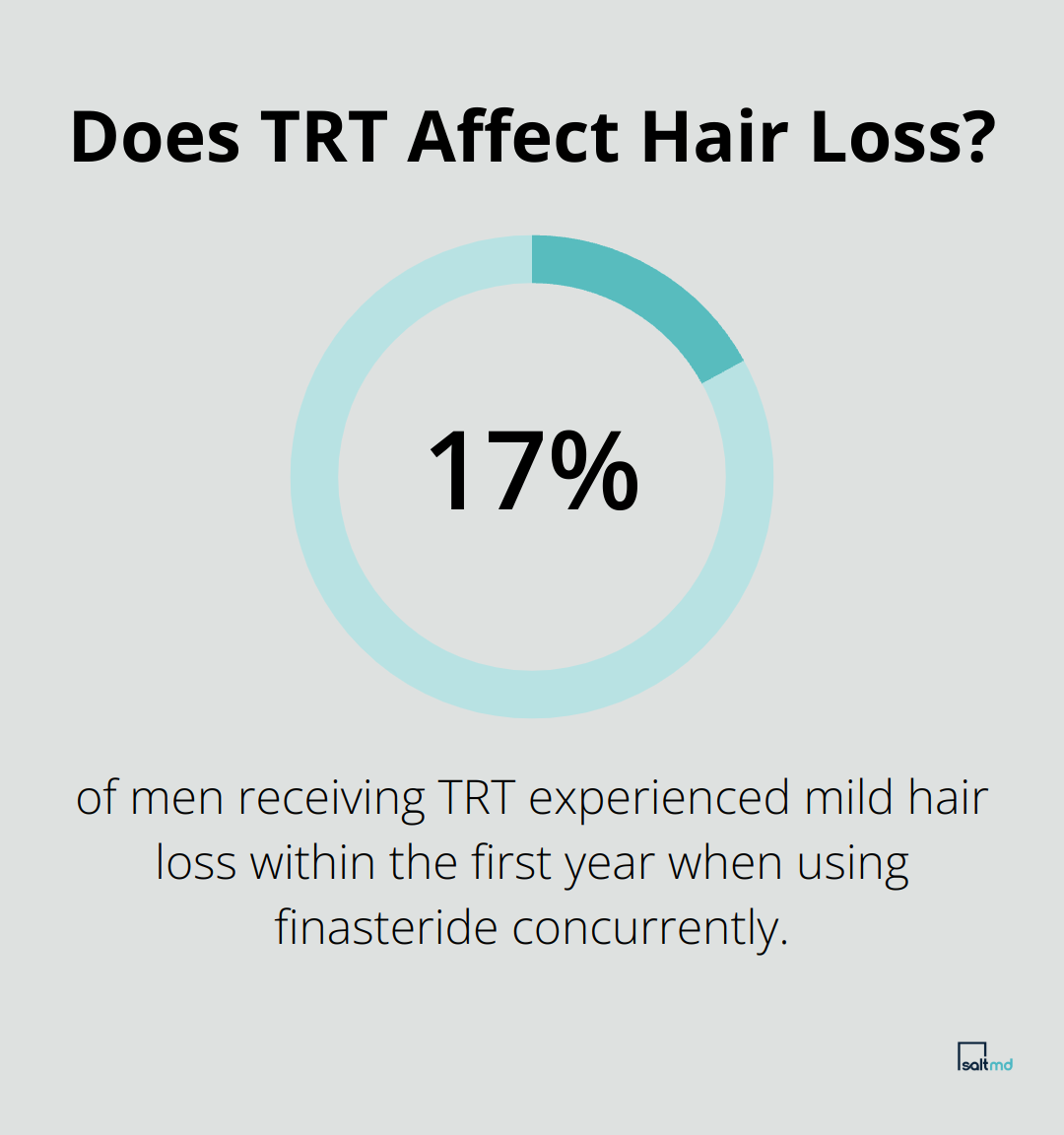
For optimal results, a daily dose of 1mg finasteride alongside a prescribed TRT regimen is recommended. This dosage effectively reduces DHT levels without interfering with the benefits of increased testosterone. However, close collaboration with a healthcare provider is essential to find the right balance for individual needs.
Administration Methods and Dosage Considerations
Finasteride and TRT administration requires a nuanced approach. While finasteride is typically taken orally, TRT offers various methods:
- Injections: Provide precise control over testosterone levels but require regular administration.
- Gels and patches: Offer convenience but may cause skin irritation for some users.
- Pellets: Inserted under the skin, provide a long-lasting option but require a minor surgical procedure.
Many men achieve the best results by combining daily oral finasteride with weekly testosterone injections. This method allows for stable hormone levels while effectively managing DHT production. However, the optimal administration method may differ based on lifestyle and individual body response.
Monitoring and Adjusting Treatment
Regular blood tests are essential when using finasteride and TRT together. Hormone levels should be checked every 8-12 weeks initially, then every 3-6 months once levels stabilize. Key markers to monitor include total and free testosterone, DHT, estradiol, and PSA (prostate-specific antigen).
If adverse effects or suboptimal results occur, treatment adjustments should be discussed with a healthcare provider. Some men benefit from adding topical finasteride to their regimen, which can provide localized DHT blocking with potentially fewer systemic effects.
The goal is to achieve hormone levels that optimize health and appearance while minimizing side effects. This often requires patience and fine-tuning over time. With careful management, the combination of finasteride and TRT can offer a powerful solution for men looking to enhance their health as they age.
As we move forward, it’s important to consider the potential side effects and risks associated with combining finasteride and TRT. Understanding these factors will help you make informed decisions about your treatment plan.
What Are the Risks of Combining Finasteride and TRT?
Finasteride and Testosterone Replacement Therapy (TRT) can offer significant benefits when used together. However, this combination also comes with potential side effects and risks. This chapter explores these concerns to help you make informed decisions about your health.
Side Effects of Finasteride
Finasteride is generally well-tolerated, but some men experience side effects. The most common issues include:
- Decreased libido
- Erectile dysfunction
- Ejaculatory disorders
These sexual side effects occur in approximately 2.1% to 3.8% of users (according to FDA data). These effects often resolve after discontinuation of the medication.
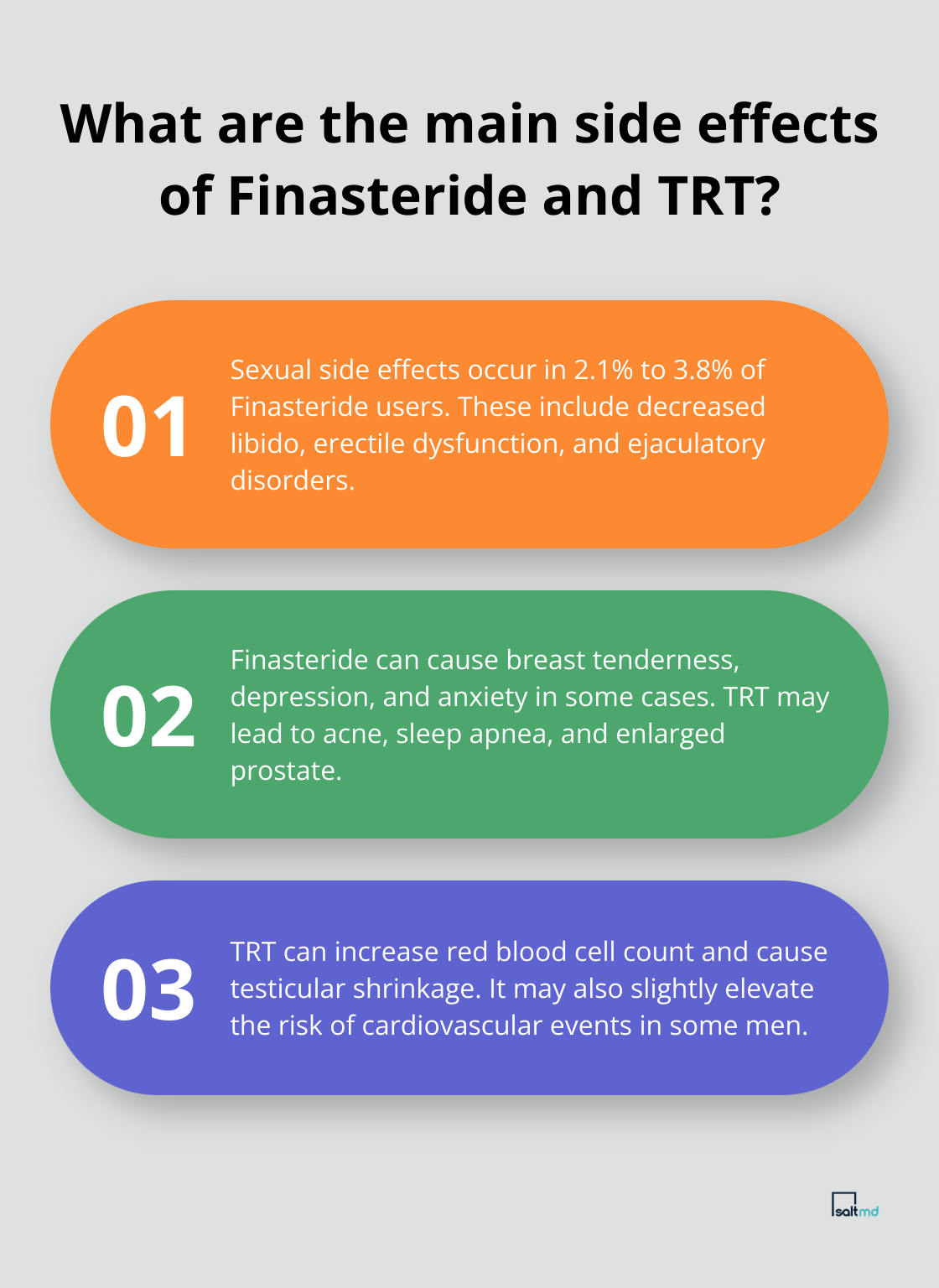
Less common side effects include:
- Breast tenderness or enlargement
- Depression
- Anxiety
In rare cases, some men report persistent sexual dysfunction even after stopping finasteride. This condition, known as Post-Finasteride Syndrome, requires further research to fully understand its mechanisms and prevalence.
Adverse Effects of TRT
Testosterone replacement therapy can cause its own set of side effects. These may include:
- Acne
- Sleep apnea
- Enlarged prostate
- Increased red blood cell count
Some men also experience testicular shrinkage and reduced sperm production, which can impact fertility.
A more serious concern is the potential increased risk of cardiovascular events. While research continues, some studies suggest a slightly elevated risk of heart attacks and strokes in men using TRT, particularly those with pre-existing heart conditions.
Interactions and Combined Effects
The use of finasteride and TRT together leads to unique considerations. Finasteride’s DHT-blocking effects may partially counteract some of the masculinizing effects of TRT, such as body hair growth. This can benefit men concerned about hair loss but may not suit those seeking maximum androgenic effects.
The combination may also affect prostate health differently than either treatment alone. While finasteride can reduce prostate size, TRT may promote prostate growth. Regular prostate screenings and PSA tests are essential for men using both treatments.
Long-Term Health Considerations
Long-term use of finasteride and TRT requires ongoing monitoring and assessment. Regular blood tests to check hormone levels, liver function, and lipid profiles are essential (every 3-6 months for men on this combined therapy).
Vigilance regarding mood changes is necessary. Both finasteride and TRT can affect mental health, with some men reporting improved mood and others experiencing increased irritability or depression. Open communication with healthcare providers about any psychological changes is vital.
The long-term effects of this combination on bone density and cardiovascular health remain areas of ongoing research. While TRT generally improves bone density, the impact of long-term DHT suppression from finasteride on bone health isn’t fully understood.
Final Thoughts
Finasteride and testosterone replacement therapy offer a powerful combination for men’s health. This dual approach manages hair loss while optimizing testosterone levels, providing a comprehensive solution for common challenges. The potential benefits include improved hair retention, increased energy, enhanced muscle mass, and better overall well-being.
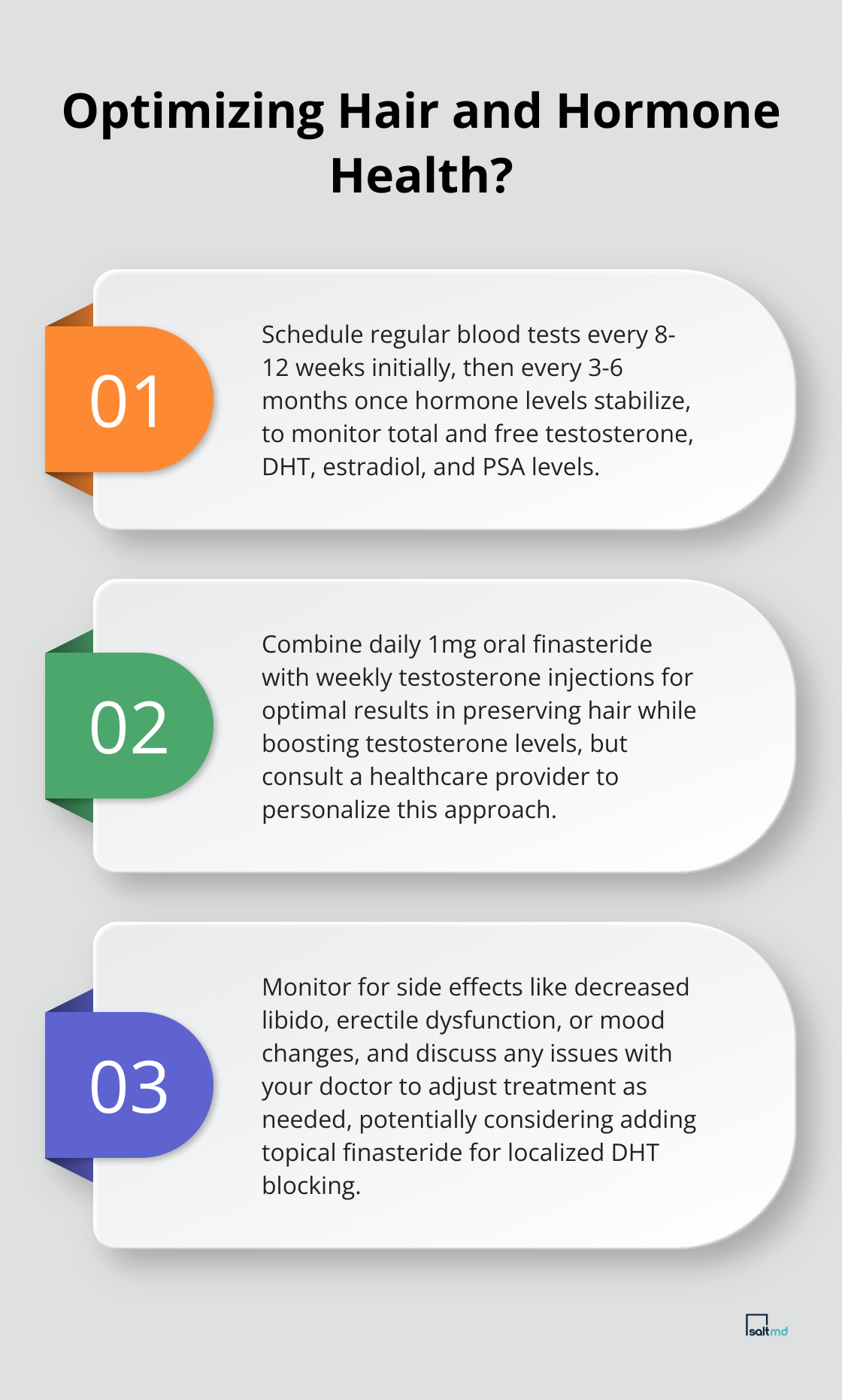
A personalized approach proves paramount when considering these treatments. Each man’s body responds uniquely, necessitating regular blood tests, prostate screenings, and open communication with healthcare providers. This ongoing dialogue allows for timely adjustments to dosages and administration methods, ensuring optimal results while minimizing risks.
The landscape of men’s health continues to evolve, with new research refining our understanding of hormone therapies. At SaltMD, we specialize in personalized hormone and peptide therapies, offering evidence-based solutions tailored to individual needs. Our approach combines advanced treatments with comprehensive care to help men achieve their health and wellness goals.

